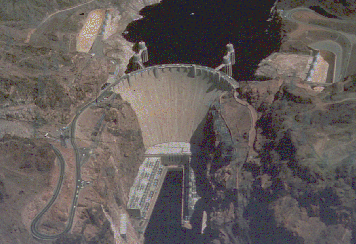

 |

|

|
|
Human beings have lived along or near the Colorado River for thousands of years. The evidence for this is the hundreds of habitation sites found throughout the Las Vegas, Lake Mead, Hoover Dam and Lake Mojave area, many of which have been dated with radiocarbon, argon, or by other measures. Some of the earliest peoples have been called "desert culture" people, basket makers, or pueblo people. It is important to remember that these names are just a convenience for those who study people and their way of life. These are not names that the people have given themselves. The descendants of the early peoples we know by more familiar names -- Paiutes, Hopi, Mojave, Yuma, Havasupai, Hualapai. These names are the names which the people have given to themselves -- for example, Havasupai means "the people of the blue-green water". The first non-native people in the Colorado River area were Spanish conquerors (conquistadores), who were looking for gold, silver or other wealth. Ulloa was the first to see the mouth of the Colorado in 1539. Cardenas, who traveled with Coronado from Mexico in 1540, was the first to see the Grand Canyon. Some of these Spanish soldiers stayed or returned to live in the area, which is why the Spanish language is so widely used today in California, Arizona, New Mexico and Nevada. The sharing of languages was not the only effect of contact between Spanish soldiers and native people. Foods, diseases, tools, horses, and a great blending of cultures was the ultimate result of the initial, sometimes unfriendly, contacts. Some two hundred years after the conquerors came, Spanish priests, such as Fathers Dominguez and Escalante in 1776, entered and explored parts of the Colorado River basin as they looked for routes of travel between their missions. It was Father Garces, also in 1776, who named the river, Rio Colorado, "river colored red." Jedediah Smith and other trappers came looking for beavers in 1826, gold miners on the way to California followed in 1849, and Mormon settlers arrived in Las Vegas in 1855. Las Vegas, which is Spanish for "the meadows," did not become a town until 1905. River explorers and mappers first came in January, 1858, under the leadership of Lt. Joseph Christmas Ives, who came up the Colorado by steamboat from the Gulf of California. He traveled as far upriver as possible to Black Canyon, the eventual site of Hoover Dam. John Wesley Powell and his men floated down the river, starting on the Colorado's main tributary, the Green River. From Green River, Wyoming, he and his men rowed all the way through the Grand Canyon. Powell made a second trip down the Colorado in 1871. The river explorers were hoping to find that the Colorado could be used as a route of travel and commerce, but because of the wide fluctuations in the amount of water from season to season, they concluded that it could not. The dam builders came in 1931. A handful of men did the planning and designing of the dam. There were another 16,000 workers who did the actual building. Many of these men had families, wives and children, who came with them. Why would so many people come out to what was, at the time, a raw, undeveloped and dangerous place to live? Essentially, because of the terrible economic times, the Depression, that was then affecting almost every part of the United States. People came from every part of the country to work at Hoover Dam. The way of life so many people had to endure -- camping out in tents or shacks along the Colorado River, some for as long as three years, without clean drinking water, toilets, or protection from the extreme weather -- makes these "common" people the real heroes of Hoover Dam. 96 men were killed in industrial accidents while building the dam. Several dozen others died from the heat or carbon monoxide poisoning while on the job, and hundreds of other people, wives and children of the workers, died from heat, polluted water or disease. Because of Hoover Dam, the Colorado River was controlled for the first time in history. Farmers received a dependable supply of water in Nevada, California and Arizona. And Los Angeles, San Diego and Phoenix and a dozen other towns and cities were given an inexpensive source of electricity, permitting population growth and industrial development. |
CAN'T FIND WHAT YOU'RE LOOKING FOR? CLICK HERE!!!